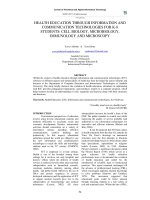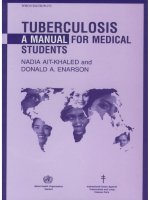WRITING y1 (STUDENTS)
Bạn đang xem bản rút gọn của tài liệu. Xem và tải ngay bản đầy đủ của tài liệu tại đây (61.78 KB, 26 trang )
WRITING
DESCRIBING AN ORGAN
DESCRIBING AN ORGAN
SHAPE
WAYS OF EXPRESSING SHAPE:
• THE HEART IS
•
•
SHAPED LIKE A CONE.
THE HEART IS CONICAL IN SHAPE.
THE HEART IS A CONE-SHAPED
ORGAN.
EXAMPLES:
•
•
•
•
•
•
•
1. THE EYE/SPHERE.
- THE EYE IS SHAPED LIKE A SPHERE.
- THE EYE IS A SPHERE-SHAPED ORGAN.
- THE EYE IS SPHERICAL IN SHAPE.
2. THE DIAPHRAGM/DOME.
- THE DIAPHRAGM IS SHAPED LIKE A DOME.
- THE DIAPHRAGM IS A DOME-SHAPED
ORGAN.
EXAMPLES:
•
•
•
•
•
•
3. THE LIVER/TRIANGLE.
- THE LIVER IS SHAPED LIKE A TRIANGLE.
- THE LIVER IS TRIANGULAR IN SHAPE.
2. THE SIGMOID COLON/S.
- THE SIGMOID COLON IS SHAPED LIKE AN S.
- THE SIGMOID COLON IS AN S-SHAPED
ORGAN.
DESCRIBING AN ORGAN
LOCATION
WAYS OF EXPRESSING LOCATION:
• LIES
• IS
• IS SITUATED
• IS LOCATED
KEY EXPRESSIONS:
-above
-below
-between
-to the left of
-to the right of
-at the top
(end) of
-at the
bottom(end)
of
-on either
sides of
-behind
-just behind
-immediately
in front of
-in front of
EXAMPLES:
• 1. The stomach lies between the liver and the
spleen.
• The stomach is to the right of the spleen.
• The stomach is to the left of the liver
• 2. The sigmoid colon is situated below the
small intestine.
• 3. The small intestine is located between the
ascending colon and the descending colon.
DESCRIBING AN ORGAN
STRUCTURE
KEY EXPRESSIONS:
-consist(s) of
-compose(s)
-contain(s)
-divide(s)
-line(s)
-cover(s)
-is/are covered by
-is/are filled with
-is/are lined with
-is/are surrounded by
-is/are separated from
-is/are divided into
-is/are made up of
is/are composed of
EXAMPLES:
1. The body is covered with skin and hair.
2. The heart is surrounded by the lungs.
3. Arteries are filled with blood.
4. The stomach is lined with a mucous coat.
5. The thorax is separated from the abdomen
by the diaphragm.
• 6. The forebrain, the midbrain and the
hindbrain make up the brain.
• 7. The brain consists of/contains the
forebrain, the midbrain and the hindbrain.
•
•
•
•
•
DESCRIBING AN ORGAN
FUNCTIONS
WAYS OF EXPRESSING FUNCTIONS:
• -THE LIVER SYNTHESISES PROTEINS.
• - ONE FUNCTION OF THE LIVER IS TO
SYNTHESISE PROTEINS.
• - THE LIVER FUNCTIONS AS AN ORGAN OF
EXCRETION.
• - THE LIVER HELPS TO EXCRETE WASTE.
• -THE LIVER IS INVOLVED/ IS CONCERNED
IN/PLAYS A PART IN THE EXCRETION OF
WASTES/WASTE EXCRETION/EXCRETING
WASTES.
USEFUL EXPRESSIONS:
VERBS
NOUNS
VERBS
NOUNS
CIRCULATE
REGULATE
EXCRETE
SECRETE
PRODUCE
DESTROY
CIRCULATION
REGULATION
EXCRETION
SECRETION
PRODUCTION
DESTRUCTION
DIGEST
FORM
FILTER
REMOVE
STORE
SYNTHESISE
DIGESTION
FORMATION
FILTRATION
REMOVAL
STORAGE
SYNTHESIS
FUNCTIONS OF SOME ORGANS
• HEART: blood circulation
• LIVER: - digestion, waste excretion, protein
synthesis, bile secretion, protein+glycogen
storage, blood glucose level regulation.
• SPLEEN: - blood filtration, antibody formation,
red cell removal and destruction.
• PANCREAS: - digestion, enzyme secretion,
hormone production
• KIDNEYS: - urea excretion, waste regulation,
hormone secretion
DESCRIBING AN ORGAN
PRACTICE
THE LIVER
•
•
•
•
•
- large, brown, triangle
- below diaphragm/ right of stomach
- 2 lobes: right and lef
- cover/peritorium
- excrete wastes, synthesise protein, secrete
bile (greenish liquid/break down fats), protect
body from bacteria, toxic and harmful
substances, store glycogen, iron, vitamins
THE LIVER (sample)
• -Introduction sentence / Topic sentence
• The liver is a large, brown, (triangular) organ. It is shaped like a
triangle.
• The liver is located below the diaphragm and to the right of the
stomach.
• It has 2 lobes: the right and the lef lobes, in which the right lobes is
bigger than
• It is covered by peritorium.
• The liver has many important functions. First, the liver helps to
excrete wastes. It also synthesises protein. Another functions of the
liver is to secrete bile (greenish liquid/break down fats), protect body
from bacteria, toxic and harmful substances, store glycogen, iron,
vitamins.
• - concluding sentence
DESCRIBING A PROCESS
ACTIONS IN SEQUENCE
•
•
•
•
•
•
•
•
- BEFORE
- AFTER
- AT THE SAME TIME AS/AS
- DURING
- WHILE
- WHEN
- UNTIL
- BY (THE BEGINNING OF/THE END OF)
CAUSE-EFFECT
• A CAUSES / PRODUCES / RESULTS IN / LEADS
TO B.
• B IS CAUSED BY / IS PRODUCED BY / RESULTS
FROM / OCCURS AS RESULT OF / OCCURS
BECAUSE OF / IS DUE TO A..............
DESCRIBING A PROCESS
PRACTICE
DESCRIBE THE PROCESS
OF FOOD FROM MOUTH TO EXCRETION
• - MOUTH - SALIVA - TONGUE
• - PHARYNX
• - ESOPHAGUS - EPIGLOTTIS
GASTROESOPHAGEAL SPHINCTER
• - STOMACH - ENZYMES - PYLORIC SPHINCTER
• - SMALL INTESTINE - INTESTINAL CELLS CAPILLARIES - LARGER VESSELS - LIVER
• - LARGE INTESTINE - WATER, SODIUM,
POTASSIUM - FECES - RECTUM - ANUS









